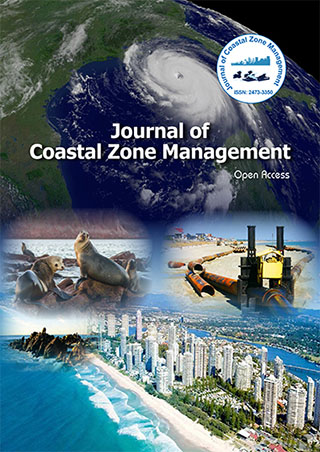Indexed In
- SafetyLit
- RefSeek
- Hamdard University
- EBSCO A-Z
- OCLC- WorldCat
- Publons
Useful Links
Share This Page
Journal Flyer

Open Access Journals
- Agri and Aquaculture
- Biochemistry
- Bioinformatics & Systems Biology
- Business & Management
- Chemistry
- Clinical Sciences
- Engineering
- Food & Nutrition
- General Science
- Genetics & Molecular Biology
- Immunology & Microbiology
- Medical Sciences
- Neuroscience & Psychology
- Nursing & Health Care
- Pharmaceutical Sciences
Opinion Article - (2023) Volume 26, Issue 6
Coastal Aquifer Management: Challenges and Opportunities
Grain Vald*Received: 01-Nov-2023, Manuscript No. JCZM-23-23790; Editor assigned: 03-Nov-2023, Pre QC No. JCZM-23-23790 (PQ); Reviewed: 24-Nov-2023, QC No. JCZM-23-23790; Revised: 01-Dec-2023, Manuscript No. JCZM-23-23790 (R); Published: 08-Dec-2023, DOI: 10.35248/2473-3350.23.26.599
Description
Coastal aquifers play a significant role in providing freshwater resources to communities around the world, but effective management of these resources is fraught with challenges. Balancing the needs of growing populations, agricultural demands, and the impacts of climate change requires innovative solutions and collaborative efforts. In this article, we will explore the challenges and opportunities associated with coastal aquifer management.
One of the primary challenges in managing coastal aquifers is the increasing demand for freshwater. Rapid population growth and urbanization place immense pressure on these aquifers as more water is needed for domestic use, industry, and agriculture. The extraction of groundwater from coastal aquifers often surpasses the natural recharge rates, leading to over-exploitation and depletion of these vital resources. Sustainable water management practices are essential to address this challenge, including the implementation of water-use efficiency measures, the promotion of water conservation, and the development of alternative water sources.
Climate change adds another layer of complexity to coastal aquifer management. Rising temperatures, altered precipitation patterns, and sea level rise directly impact the quantity and quality of freshwater available in these aquifers. Changes in precipitation can affect recharge rates, while sea level rise contributes to saltwater intrusion, making the freshwater in coastal aquifers more vulnerable to contamination. To effectively manage coastal aquifers in the face of climate change, adaptive strategies must be employed, including the development of resilient infrastructure, groundwater monitoring systems, and the implementation of climate-resilient water supply projects.
Saltwater intrusion is a significant threat to coastal aquifers, particularly in low-lying areas. As sea levels rise, saline water infiltrates freshwater aquifers, compromising their quality and potability. This intrusion not only reduces the availability of freshwater for communities but also poses challenges for agriculture dependent on irrigation. To mitigate saltwater intrusion, a combination of engineering solutions and sustainable water use practices is necessary. Coastal communities may need to invest in barriers and wells designed to prevent the encroachment of saltwater and promote the sustainable extraction of freshwater.
Integrated water resource management is a key opportunity in addressing the challenges faced by coastal aquifers. This approach involves coordinating the use of surface water and groundwater resources to ensure sustainability and meet the diverse needs of communities. By adopting a comprehesive perspective, decisionmakers can better understand the interconnected nature of water systems and implement strategies that maximize the benefits of both surface water and groundwater. This includes the development of comprehensive water governance frameworks, stakeholder engagement, and the integration of scientific research into management practices.
Technological advancements also present opportunities for improving coastal aquifer management. Remote sensing, Geographic Information System (GIS) technologies, and advanced modeling tools enable more accurate mapping of aquifer dynamics, groundwater recharge rates, and significant areas of saltwater intrusion. These tools empower decisionmakers to make informed choices in resource allocation, monitoring, and response planning. Additionally, innovative water treatment technologies can enhance the quality of extracted water, making it suitable for various uses even in the presence of saltwater intrusion.
Community involvement and awareness are vital components of successful coastal aquifer management. Engaging local communities in the decision-making process, raising awareness about the importance of water conservation, and promoting sustainable practices can foster a sense of ownership and responsibility. Collaborative efforts between government agencies, non-profit organizations, researchers, and the public can lead to more effective and sustainable coastal aquifer management practices.
In conclusion, managing coastal aquifers presents a complex set of challenges, but there are also promising opportunities for sustainable and effective solutions. By implementing integrated water resource management strategies, leveraging technological advancements, and fostering community engagement, we can navigate the complexities of coastal aquifer management and ensure a resilient and secure freshwater supply for present and ensuing generations.
Citation: Vald G (2023) Coastal Aquifer Management: Challenges and Opportunities. J Coast Zone Manag. 26.599.
Copyright: © 2023 Vald G. This is an open-access article distributed under the terms of the Creative Commons Attribution License, which permits unrestricted use, distribution, and reproduction in any medium, provided the original author and source are credited.
